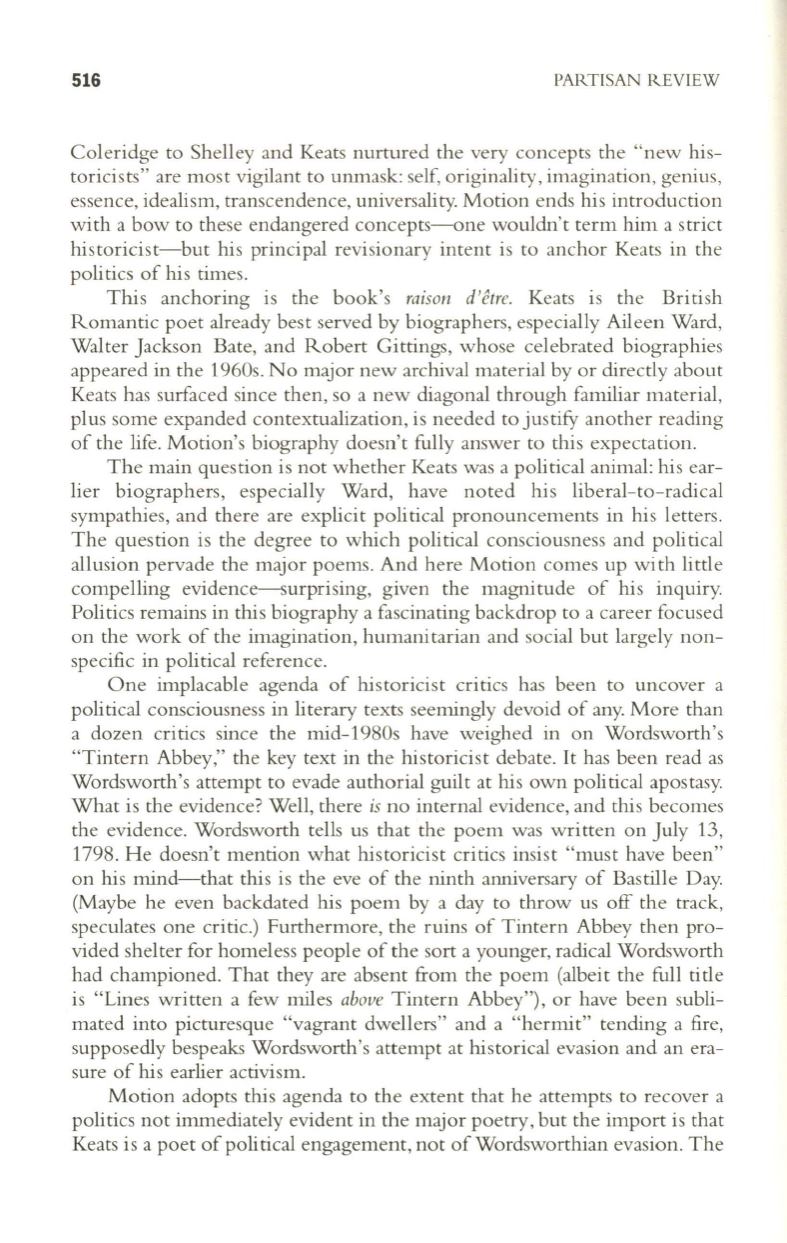
516
PARTISAN REVIEW
Coleridge to Shelley and Keats nurtured the very concepts the "new his–
toricists" are most vigilant to unmask: self, originality, imagination, genius,
essence, idealism, transcendence, universality. Motion ends his introduction
with a bow to these endangered concepts-one wouldn't term him a strict
historicist-but his principal revisionary intent is to anchor Keats in the
politics of his times.
This anchoring is the book's
raison d'etre.
Keats is the British
Romantic poet already best served by biographers, especially Aileen Ward,
Walter Jackson Bate, and Robert Gittings, whose celebrated biographies
appeared in the 1960s. No major new archival material by or directly about
Keats has surfaced since then, so a new diagonal through familiar material,
plus some expanded contextualization, is needed to justify another reading
of the life. Motion's biography doesn't fully answer to this expectation.
The main question is not whether Keats was a political animal: his ear–
lier biographers, especially Ward, have noted his liberal-to-radical
sympathies, and there are explicit political pronouncements in his letters.
The question is the degree to which political consciousness and poli tical
allusion pervade the major poems. And here Motion comes up with little
compelling evidence-surprising, given the magnitude of his inquiry.
Politics remains in this biography a fascinating backdrop to a career focused
on the work of the imagination, humani tarian and social but largely non–
specific in political reference.
One implacable agenda of historicist critics has been to uncover a
political consciousness in literary texts seemingly devoid of any. More than
a dozen critics since the mid-1980s have weighed in on Wordsworth's
"Tintern Abbey," the key text in the historicist debate.
It
has been read as
Wordsworth's attempt to evade authorial guilt at his own political apostasy.
What is the evidence? Well, there
is
no internal evidence, and this becomes
the evidence. Wordsworth tells us that the poem was written on July 13,
1798. He doesn't mention what historicist critics insist "must have been"
on his mind-that this is the eve of the ninth anniversary of Bastille Day.
(Maybe he even backdated his poem by a day to throw us off the track,
speculates one critic.) Furthermore, the ruins of Tintern Abbey then pro–
vided shelter for homeless people of the sort a younger, radical Wordsworth
had championed. That they are absent from the poem (albeit the full title
is "Lines written a few miles
above
Tintern Abbey"), or have been subli–
mated into picturesque "vagrant dwellers" and a "hermit" tending a fire,
supposedly bespeaks Wordsworth's attempt at historical evasion and an era–
sure of his earlier activism.
Motion adopts this agenda to the extent that he attempts to recover a
politics not immediately evident in the major poetry, but the import is that
Keats is a poet of political engagement, not of Wordsworthian evasion. The


